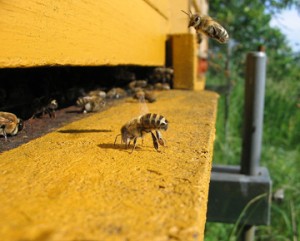Apparently what was apparent to many scientists and researchers back in 2008 is becoming more apparent – or not. Honeybee Colony Collapse Disorder (CCD) has been raising hackles and eyebrows for the better part of the last decade. CCD, characterized by the sudden disappearance of most of the adult bees in a colony, began making real headlines around 2006. And not long after, one particular class of pesticides – neonicotinoids – became a prime suspect.
I wrote about these events in the Wednesday, 10 December 2008, Naturalist’s Corner: see: http://www.smokymountainnews.com/archives/item/4592-the-naturalists-corner. Here are some excerpts:
“The alleged culprit is a synthetic nicotine known as imidacloprid used in a plethora of pesticides around the world. Imidacloprid has been patented since 1988 but only gained widespread use in the past few years when pesticides containing diazinon were banned and pulled off the shelves. Bayer the original patent holder markets imidacloprid through many trade names but the pesticide Merit is the most common. Other products that contain imidacloprid include Admire, Premise, Muralla, Leverage, Trimax and many more.
“While Bayer denies any of its products cause CCD, according to a recent story in the High Country Press by Sam Calhoun, the company has paid out $70 million to beekeepers in France and at least 16 European countries have banned imidacloprid. Another neonicotinoid, clothianidin, has also been implicated in CCD and was recently banned in Germany.”
Shortly after these accusations more research, some sponsored by the United States Department of Agriculture, came to light. And while all these studies admit that neonicotinoids are quite lethal to honeybees many suggested that cause and effect could not be conclusively determined because there were so many variables involved. The idea of neonicotinoids as the primary culprit regarding CCD seemed to have been shoved to the back burner, at least in the U.S.
Then in April of 2012 a study by Alex Lu of Harvard’s School of Public Health, once again pointed to imidacloprid as a primary agent in CCD. But once again, other researchers jumped in to muddy the waters.
Not long after the Harvard study a study by UK scientists at the University of Exeter along with the British Food and Environment Agency hit the streets claiming that a French ban on Swiss pesticide manufacturer Syngenta’s Cruiser OSR, whose main ingredient is a neonicotinoid was unfounded.
Of course, it must be my bias – but I found it rather intriguing that one commenter regarding the Exeter study noted that it was actually Syngenta that paid for the research. I must surely be one of those conspiracy kooks to thing that Bayer – the number one pesticide producer in the world and a company like Syngenta (who ranks around sixth, I believe) could have any influence on science.
Those pesticides have to go through rigorous testing before they’re allowed on the market, right? Wrong. The process is known as conditional registration, whereby the registrant – say Bayer – promises, oh, don’t worry will check this stuff out – just let us get it on the market. And then there’s that funding thing again. Bayer made for the tests they submitted to the EPA, which the EPA (gasp) accepted carte blanche till they started getting a little heat and now are reconsidering their options.
I don’t expect any major movement on CCD till there can be documented population research in those countries that have banned neonicotinoids. Research is already present here and abroad showing precipitous drops in honeybee populations that correspond to the mass introduction of neonicotinoids into the landscape – if populations rebound where those chemicals are removed, that’ll be the nail in the coffin. Till then it’s just serve and volley.

